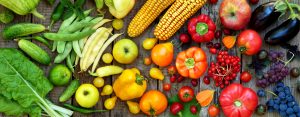 Do you think you eat enough fruits and vegetables every day? You may track your macronutrients, have an apple a day, and be free of digestive concerns but still be missing the mark. A recent report by the Centers for Disease Control (CDC) has found that most adults in the United States could stand to eat a lot more fruits and vegetables each day.
Do you think you eat enough fruits and vegetables every day? You may track your macronutrients, have an apple a day, and be free of digestive concerns but still be missing the mark. A recent report by the Centers for Disease Control (CDC) has found that most adults in the United States could stand to eat a lot more fruits and vegetables each day.
Health Benefits of Fruits and Vegetables
Studies have shown that the more fruits and vegetables people eat, the less likely they are to have heart disease. This is because a diet rich in fruits and vegetables contains a lot of fiber and nutrients, which in itself can help many aspects of health including:
- improvement of blood pressure
- lowering cancer risk
- decreasing risk of getting diabetes
- prevention of constipation
- keeping the digestive system healthy
- maintaining eye health
More recently, it has been found that the phytonutrients from fruits and vegetables provide many of its health benefits. For example, the carotenoids found in many brightly colored fruits and vegetables such as tomatoes and carrots have many health benefits. One of the carotenoids, lycopene, has shown potential for reducing risk of prostate cancer. Furthermore, research has shown that another phytonutrient, lutein, has been shown to reduce risk for cataracts. However, more studies need to be done to show the full health benefits of such phytonutrients.
What is the recommended intake for fruits and vegetables daily?
According to the United States Department of Agriculture (USDA), most people should consume about 2 cups of fruits and 2.5 cups of vegetables every day. This amount of produce would help you to reach the recommended daily fiber intake of most adults, which is around 21 to 30 grams. However, some may think that fiber supplements will do the job if they don’t want to eat fruits and vegetables. Although fiber supplements may be helpful for filling the gap of your daily fiber needs, they should not be relied upon for your full daily intake of fruits and vegetables. This is because the fiber supplements will not provide the many health nutrients that fruits and vegetables provide.
CDC Fruit and Vegetable Intake Report
A recent report from the CDC found that only 12-percent of Americans are eating enough fruits and vegetables. High cost and limited access to fruits and vegetables seem to be the biggest barriers to meeting daily recommended intakes. However, a report by the USDA found that it is possible to meet such intakes for about $2.10 to $2.60 per day.
Fresh apples, orange, and carrots were found to be some of the lowest cost produce. Also, frozen green beans, canned corn, romaine lettuce, and Roma tomatoes were some of the least pricey produce options. However, this amount may still be a lot for more low-income families. In those cases, the following tips may be helpful in ensuring everyone can get in their daily dose of fruits and vegetables.
- Buy produce when it is in season. This is because if more of a type of produce is being harvested, the cost will be less for you. An added bonus is that in-season produce will also be more flavorful.
- Check to see what Supplemental Nutrition Assistance Program (SNAP) benefits provide. Recent benefits provide funds to purchase produce at local farmer’s markets. For this reason, such funds could help offset any produce costs you may incur at the supermarket.
- Buy frozen produce in bulk. You can often find family size bags of frozen veggies at lower cost than their smaller size counterparts. In addition, frozen produce will not go bad as quickly, so you do not have to worry about any waste if you do not eat it right away.
Fitting More Fruits and Veggies in Your Day
Follow the tips below to get more fruits and vegetables into your daily routine.
- Slice up some apples with a side of peanut butter for a sweet and salty treat.
- Keep it simple with some salt and pepper and a drizzle of olive oil. Toss veggies in these simple ingredients, then bake on a cookie sheet for 400 degrees Fahrenheit for about 25-45 minutes, depending on the thickness of the produce you are cooking. This roasted cooking method will bring out the natural sweet and savory flavors of produce.
- Pair a cup of baby carrots with some hummus or Greek yogurt dressing for a salty, crunchy snack.
- Load up your lunch bowl with salad greens, cucumbers, tomatoes, carrots, and top with nuts and seeds for extra fiber power.
- Replace your nighttime chocolate piece with a cup of grapes or berries over Greek yogurt for a filling sweet treat.
- Use veggies as a foundation for your favorite recipes to add fiber. Use spaghetti squash or spiralized zucchini instead of spaghetti or riced cauliflower instead of mashed potatoes.
If you are having trouble meeting your daily fruit and vegetable needs, add a daily multivitamin such as Zestia by Vita Sciences. Zestia contains a potent mix of superfood complexes, fruit and vegetable compounds, probiotics, and digestive enzymes to help support optimal overall health.
-written by Staci Gulbin, MS, MEd, RD, LDN
Sources:
Harvard T.H. Chan School of Public Health (accessed November 20, 2017) “Vegetables and Fruits.”
Medline Health News (November 16, 2017) “CDC Wants America to Eat Its Fruits & Veggies.”
United States Department of Agriculture (August 2, 2017) “SNAP and Farmer’s Markets.”